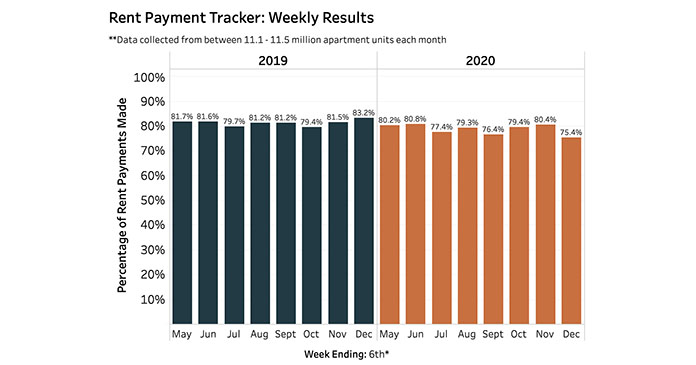The National Multifamily Housing Council (NMHC)’s Rent Payment Tracker found 75.4 percent of apartment households made a full or partial rent payment by December 6 in its survey of 11.5 million units of professionally managed apartment units across the country.
This is a 7.8 percentage point, or 894,864 household decrease from the share who paid rent through December 6, 2019 and compares to 80.4 percent that had paid by November 6, 2020. It should be noted that December 5th and 6th fell on a weekend in 2020 and therefore may not be a direct comparison to last year’s figures. These data encompass a wide variety of market-rate rental properties across the United States, which can vary by size, type and average rental price.
“While the initial rent collection figures for the first week of December are concerning, only a full month’s results will paint a complete picture. However, it should not come as a surprise that a rising number of households are struggling to make ends meet. As the nation enters a winter with increasing COVID-19 case levels and even greater economic distress – as indicated by last week’s disquieting employment report – it is only a matter of time before both renters and housing providers reach the end of their resources,” said Doug Bibby, NMHC President.
“The recent news that legislators in Congress may be coming closer to finding common ground is encouraging, but it is critical that any package includes meaningful rental assistance and other critical support such as an extension of unemployment benefits and short-term liability protections. At the same time, lawmakers should be cautious of extending eviction moratoria – an approach that will only result in untenable amounts of debt for households across the country.”
The NMHC Rent Payment Tracker metric provides insight into changes in resident rent payment behavior over the course of each month, and, as the dataset ages, between months. While the tracker is intended to serve as an indicator of resident financial challenges, it is also intended to track the recovery as well, including the effectiveness of government stimulus and subsidies.
However, noteworthy technical issues may make historical comparisons imprecise. For example, factors such as varying days of the week on which data are collected; individual companies’ differing payment collection policies; shelter-in-place orders’ effects on residents’ ability to deliver payments in person or by mail; the closure of leasing offices, which may delay operators’ payment processing; and other factors can affect how and when rent data is processed and recorded.
Find more information, including the methodology, on the NMHC Rent Payment Tracker here.
The NMHC Rent Payment Tracker FAQ can be found here.













